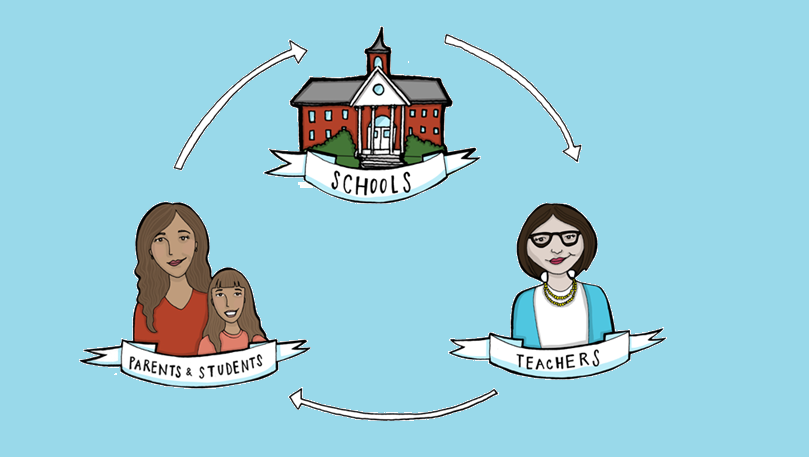Significance of Parental and Teacher Guidance During Impressionable Adolescence

 One of the most interesting age-segments in the life span of all of us, undeniably, is 10-15 years, when most of the school-going children are studying in classes ranging from 5th to 9th. Much has been written about the toddlers and young children in the age group 1-8 years. Parents and child psychologists seem to spend more time in tending and researching this age-group for several reasons, and one of them happens to be a general perception of fragility in the physical and cognitive context.
One of the most interesting age-segments in the life span of all of us, undeniably, is 10-15 years, when most of the school-going children are studying in classes ranging from 5th to 9th. Much has been written about the toddlers and young children in the age group 1-8 years. Parents and child psychologists seem to spend more time in tending and researching this age-group for several reasons, and one of them happens to be a general perception of fragility in the physical and cognitive context.
In comparative terms much less has been written or commented upon the age band, most of us associate with adolescence. This is indeed, a very interesting stage because it marks the transitional phase of growth and development between childhood and adulthood.
The etymology of the word adolescence lies in the Latin word ‘adolescere’, which means ‘to grow up’. It is also a transitional stage of physical and psychological development that generally occurs during the period from puberty to legal adulthood, which is the age of majority. Adolescent is sometime used to describe young people who are no longer children but have not yet become adults. It also refers to their behavior. English language often equates adolescence with synonyms like immature, teen juvenile etc.
Several physiological changes keep happening, from the time an infant is born, but these take place in a very protected environment where figuratively speaking, every step taken by a child is guided. There is also a pronounced change/growth that is visible in the physio-musculoskeletal frame of a child which is essential for the development of his physical strength, motor and kinaesthetic skills. For example a baby has 300 bones and by the time he grows into adulthood he is left with 206. By the time a child reaches the age of 10 years, he manages to gain a smart control in areas such as physical growth and development, thinking and reasoning, emotional and social development, language development and sensory and motor development. Much of the foundational work of the child growth is done by now and he is now ready to take-off on a faster trajectory of growth on all fronts.
Child psychologists never tire of saying that much of what we are is done in the first 8-10 years of our existence. There is indeed, enormous truth in this statement, but much remains to be done yet in the next 6-7 years, and that is where we need to focus our attention.
Ironically, an adolescent is not too young to be kept under a watchful eye, nor is he too old to be treated as an adult. He is somewhere in between, and largely seeks answers to many questions on his own, that arise in his not-yet fully grown neural system. This is also the age when very distinct and perceptible changes are happening in his physiological structure. The hormonal disruptions, heaviness in his voice, growth of hair on hitherto soft skin, are all visible signs of the transition. He also experiences gender differences, sexuality in a soft and subtle manner. These are new experiences, partly weird and partly pleasant, and he is yet to come to terms with them. The parallel experiences for girls is however traumatic and both adolescent boy and girl desperately need someone to confide in. They need a confidant who helps them understand, does not laugh at them nor frightens or confuses them. The respective parents are perhaps the best allies in such situations. Sometimes children hesitate to open up, and it is the responsibility of the parents to engage them in a mature conversation and disabuse their minds from all fears and give a clear perspective.
More than the physiological changes, something more profound is going on inside the adolescent’s mind and intellect, which is far more subtle, strong and yet completely invisible. His cognitive capabilities are on a rise and these are on an exponential trajectory. He starts developing logical reasoning, analytical abilities and begins to understand right from wrong. A few years prior to this stage he was always told and he seldom questioned. In fact, these became embedded in his sub-conscious and substantially influenced his habits, reflexes and some of the negative emotions which he may have sub-consciously acquired during the observational phase of his early childhood. He can tell right from wrong but perhaps does not fully understand the consequences of either action.
But this stage is very critical and deserves to be observed by parents and teachers from a very close quarters. His intellect is developing but is very sharp. Most importantly, it is yet not contaminated with externalities of any kind. It is raw, virgin and intensely productive. He is not yet stressed up unlike his seniors studying in classes 10 onwards who are carrying an unusually heavy burden of Board examinations, competitions. Adolescent has not even made a choice of what he or she wants to do. This is the right time to bring in all elements of intellectual stimuli with respect to critical thinking, creativity, collaboration, communication and put them on a track of higher order thinking. On the academic front he is most receptive at this phase and teachers will do well to spend time in creating concept clarity, develop scientific temper and create opportunities of experiential learning.
This is also a dangerous age when a child is extremely impressionable. It is easy for him to get carried away by the glitter or temptations of the world to which he has a better access now. The peer group influence, company of friends from varied backgrounds, desire to try out new things, especially those that are forbidden have the potential to lead him astray. Again this is the age where children need their parents the most and parents should develop requisite knowledge and sensitivity to spend adequate time with them. Although, there is no straitjacketed approach to this, but mother with daughters, and fathers with sons, and combination of profound love and affection from both of them will create great individuals and strengthen unbreakable family bonds.
Mr. Vinod Malhotra
Director – Corporate Relations
Seth Anandram Jaipuria Group of Educational Institutions
